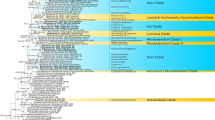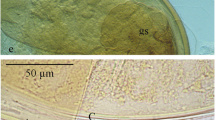Abstract
Many rust fungi that infect Rhododendron belong to the genus Chrysomyxa or the anamorph genus Caeoma. Their morphological resemblance suggests a close taxonomical relationship, however, their phylogenetic relatedness remains unknown. To reveal the phylogenetic affinity and clarify informative morphological characters, we analyzed the sequences of the internal transcribed spacer region of the nuclear ribosomal DNA of 56 isolates representing four species of Caeoma and their allied genus Chrysomyxa, which infect Rhododendron from China. The analysis revealed that Caeoma and Chrysomyxa cluster in the same clade and intermix, thus new combinations in Chrysomyxa have been provided for Caeoma that infect Rhododendron. We also provide expanded descriptions and illustrations of the aecia of Chrysomyxa yunnanensis and the uredinia of Chrysomyxa zhuoniensis for the first time. This study advances our understanding of evaluating some asexually typified generic names of rust fungi using molecular data to determine their correct placement.









Similar content being viewed by others
References
Aime MC, Castlebury LA, Abbasi M, Begerow D, Berndt R, Kirschner R, Marvanova L, Ono Y, Padamsee M, Scholler M, Thines M, Rossman AY (2018) Competing sexual and asexual generic names in Pucciniomycotina and Ustilaginomycotina (Basidiomycota) and recommendations for use. IMA Fungus 9(1):75–89
Berndt R (1999) Chrysomyxa rust: morphology and ultrastructure of D-haustoria, uredinia and telia. Can J Bot 77:1469–1484
Cao XW (2000) Studies of the pathogen and alternative host of Picea asperata mast. and Picea crassifolia Kom. J Cent South Univ 20:78–80
Cao ZM, Li ZQ (1996) Tree rusts in Qinling Mountains. J Northwest For Univ 11:91–98
Cao ZM, Li ZQ (1999) Rust fungi of Qinling Mountains. China Forestry Publishing House, Beijing
Cao J, Tian CM, Liang YM, You CJ (2017a) Two new Chrysomyxa rust species on the endemic plant, Picea asperata in Western China, and expanded description of C. succinea. Phytotaxa 292(3):218–230
Cao J, Tian CM, Liang YM, You CJ (2017b) A new rust species of Diaphanopellis on Rhododendron oreodoxa from southern China. Phytotaxa 309(1):55–65
Crane PE (2001) Morphology, taxonomy and nomenclature of the Chrysomyxa ledi complex and related rust fungi on spruce and Ericaceae in North America and Europe. Can J Bot 79:957–982
Crane PE (2003) Caeoma cassiopae sp. nov., a rust on Cassiope tetragona in the Canadian Rocky Mountains. Mycologia 95:156–159
Crane PE (2005) Rust fungi on rhododendrons in Asia: Diaphanopellis forrestii gen. Et sp. nov., new species of Caeoma, and expanded descriptions of Chrysomyxa dietelii and C. succinea. Mycologia 97:534–548
Crane PE, Yamaoka Y, Engkhaninum J, Kakishima M (2005) Caeoma tsukubaense n. sp., a Rhododendron rust fungus of Japan and southern Asia, and its relationship to Chrysomyxa rhododendri. Mycoscience 46:143–147
Cummins GB, Hiratsuka Y (2003) Illustrated genera of rust fungi, 3rd edn. The American Phytopathological Society Press, St. Paul
Fang RC (1999) Flora Republicae Popularis Sinicae. Tomus 57, No. 1. Science Press, Beijing, pp 13–15
Feau N, Vialle A, Allaire M, Tanguay P, Joly DL, Frey P, Brenda EC, Hamelin RC (2009) Fungal pathogen (mis-) identifications: a case study with DNA barcodes on Melampsora rusts of aspen and white poplar. Mycol Res 113(6–7):713–724
Feau N, Vialle A, Allaire M, Maier W, Hamelin RC (2011) DNA barcoding in the rust genus Chrysomyxa and its implications for the phylogeny of the genus. Mycologia 103(6):1250–1266
Felsenstein J (1985) Phylogenies and the comparative method. Am Nat 125(1):1–15
Frederick ZA, Villani S, Cox KD, Los L, Allen J (2011) First report of white pine blister rust caused by Cronartium ribicola on immune black currant Ribes nigrum cv. Titania in Preston, Connecticut. Plant Dis 95(12):1589
Gould CJ (1966) Research on Chrysomyxa rusts attacking rhododendrons. Bulletin of the American Rhododendron Society 20:217–220
Gould CJ, Eglitis M, Doughty CC (1955) European Rhododendron rust (Chrysomyxa ledi var. rhododendri) in the United States. Plant Dis Rep 39:781–782
Halliday P (2001) The illustrated Rhododendron. Their classification portrayed through the artwork of Curtis's botanical magazine. Timber Press, Portland
Hantula KJ (1998) Melampyrum sylvaticum, a new alternate host for pine stem rust Cronartium flaccidum. Mycologia 90(6):1028–1030
He BZ, Hou WH, Liu NC, Shao LP, Xue Y, You SZ (1995) The study of spruce bud rust disease. J Northeast For Univ 23:112–114
Hietala AM, Solheim H, Fossdal CG (2008) Real-time PCR-based monitoring of DNA pools in the tri-trophic interaction between Norway spruce, the rust Thekopsora areolata, and an opportunistic Ascomycetous phomopsis sp. Phytopathology 98(1):51
Hiratsuka N, Kaneko S (1975) Surface structure of Coleosporium spores. Reports of the Tottori Mycological Institute 12:1–13
Hiratsuka N, Sato S, Katsuya K, Kakishima M, Hiratsuka Y, Kaneko S, Ono Y, Sato T, Harada Y, Hiratsuka T, Nakayama K (1992) The rust flora of Japan. Tsukuba Shuppankai, Tsukuba
Kaitera J, Tillman-Sutela E, Kauppi A (2010) Chrysomyxa ledi, a new rust fungus sporulating in cone scales of Picea abies in Finland. Scand J For Res 25(3):202–207
Katoh K, Standley DM (2013) MAFFT multiple sequence alignment software version 7: improvements in performance and usability. Mol Biol Evol 30:772–780
Larget B, Simon DL (1999) Markov chain Monte Carlo algorithms for the Bayesian analysis of phylogenetic trees. Mol Biol Evol 16(6):750–759
Laundon GF (1967) The taxonomy of the imperfect rusts. Trans Br Mycol Soc 50:349–353
Lee SK, Kakishima M (1999) Aeciospore surface structures of Gymnosporangium and Roestelia (Uredinales). Mycoscience 40:109–120
Liang YM, Tian CM, Kakishima M (2006) Phylogenetic relationships on 14 morphologically similar species of Pucciniastrum in Japan based on rDNA sequence data. Mycoscience 47(3):137–144
Maier W, Begerow D, Weiß M, Oberwinkler F (2003) Phylogeny of the rust fungi: an approach using nuclear large subunit ribosomal DNA sequences. Can J Bot 81(1):12–23
Marion KS, Louise M, Marlien van der M, Harry CE, Angel R (2008) Are the microcyclic rust species Puccinia melampodii and Puccinia xanthii conspecific? Mycol Res 113(11):1271–1282.
Moricca S, Maresi G (2010) Melampsoridium hiratsukanum reported for the first time on grey alder in Italy. New Dis Rep 21:17
Ono Y, Kakishima M, Kudo A, Sato S (1986) Blastospora smilacis, a teleomorph of Caeoma makinoi, and its sorus development. Mycologia 78:253–262
Ono Y, Kakishima M, Sato S, Harada Y (1987) Blastospora itoana on Smilax nipponica forms a Caeoma stage on Prunus grayana in Japan. Mycologia 79:668–673
Pethybridge HG (1918) Chrysomyxa abietis in Ireland. Ir Nat 27(8):130
Philipson MN, Philipson WR (1994) Rhododendron research: classification, anatomy, history. Horticulture NZ 5(1):10–12
Ronquist F, Huelsenbeck JP, Vander Mark P (2005) MrBayes 3.1 manual, pp 1–69
Sato T, Sato S (1982) Aeciospore surface structure of the Uredinales. Trans Mycol Soc Jpn 23:51–63
Singh P, Carew GC (1990) Inland spruce cone rust of black spruce: effect on cone and seed yield, and seed quality. For Pathol 20:397–404
Smith JA, Blanchette RA, Newcombe G (2004) Molecular and morphological characterization of the willow rust fungus, Melampsora epitea, from arctic and temperate hosts in North America. Mycologia 96(6):1330–1338
Sundelin T, Collinge DB, Mette L (2009) A cultivation independent, PCR-based protocol for the direct identification of plant pathogens in infected plant material. Eur J Plant Pathol 123(4):473–476
Suyama Y, Kawamuro K, Kinoshita I, Yoshimura K, Tsumura Y, Takahara H (1996) DNA sequence from a fossil pollen of Abies spp. from Pleistocene peat. Genes Genet Syst 71:145–149
Swofford DL (2000) PAUP*: phylogenetic analysis using parsimony (and other methods). Version 4.0b10. Sinauer Associates, Sunderland
Tai FL (1979) Sylloge Fungorum Sinicorum. Science Press, Beijing
Takahashi O, Saho H (1985) Notes on the Japanese rust fungi IV. Dissemination of Chrysomyxa abietis (Wallroth) Unger. Trans Mycol Soc Jpn 26:433–439
Tillman-Sutela E, Kauppi A, Hilli A, Kaitera J (2004) Fungal injury to seed tissues of Norway spruce, Picea abies (L.) karst. Trees 18:151–156
Virtudazo EV, Nakamura H, Kakishima M (2001) Phylogenetic analysis of sugarcane rusts based on sequences of ITS, 5.8S rDNA and D1/ D2 regions of LSU rDNA. J Gen Plant Pathol 67:28–36
Wang YC (1987) A new spruce needle rust fungus. Acta Mycol Sin 6:86–88
Wilson AW, Beckerman JL, Aime MC (2014) First report of the white pine blister rust fungus, Cronartium ribicola, on Ribes odoratum in Indiana. Plant Dis 98(2):277
Yang T, Tian CM, Liang YM, Kakishima M (2014) Thekopsora ostryae (Pucciniastraceae, Pucciniales), a new species from Gansu, northwestern China. Mycoscience 55(4):246–251
Yang CH, Xie ZG, Yu YF, Yang ZR (2015) Rhododendron leigongshanense (Ericaceae), a new species from China. Bangladesh J Plant Taxon 22(2):119–123
You CJ, Liang YM, Li J, Tian CM (2010) A new rust species of Coleosporium on Ligularia fischeri from China. Mycotaxon 111:233–239
Zhang XL (2005) Preliminary study on leaf rust of Picea crassifolia in Lianhuashan National Nature Reserve of Gansu Province. J Gansu For Sci Tech 31:32–48
Zhao ZY (1958) Three spruce rusts in Tianshan forest farm. J Xinjiang Agric Sci 190–192
Acknowledgments
This work was supported by National Natural Science Foundation of China (No. 31770683) and The Fundamental Research Funds for the Central Universities, China (No. 2018ZY23). We want to thank the Herbarium Mycologicum Academiae Sinicae, Beijing, China (HMAS) for providing specimens. CJY acknowledges the help and inspiration from Dr. Clement Tsui, Department of Pathology and Laboratory Medicine, Weill Cornell Medicine, Qatar.
Funding
The author CJY thanks National Natural Science Foundation of China (Grant No: 31770683) and The Fundamental Research Funds for the Central Universities, China (Grant No: 2018ZY23) for the financial support.
Author information
Authors and Affiliations
Corresponding author
Ethics declarations
Conflict of interest
The authors declare that they have no conflict of interest.
Additional information
Section Editor: Meike Piepenbring
Publisher’s note
Springer Nature remains neutral with regard to jurisdictional claims in published maps and institutional affiliations.
Rights and permissions
About this article
Cite this article
You, C.J., Yang, L.J. & Tian, C.M. Resolving the phylogenetic position of Caeoma spp. that infect Rhododendron and Chrysomyxa from China. Mycol Progress 18, 1285–1299 (2019). https://doi.org/10.1007/s11557-019-01524-z
Received:
Revised:
Accepted:
Published:
Issue Date:
DOI: https://doi.org/10.1007/s11557-019-01524-z




